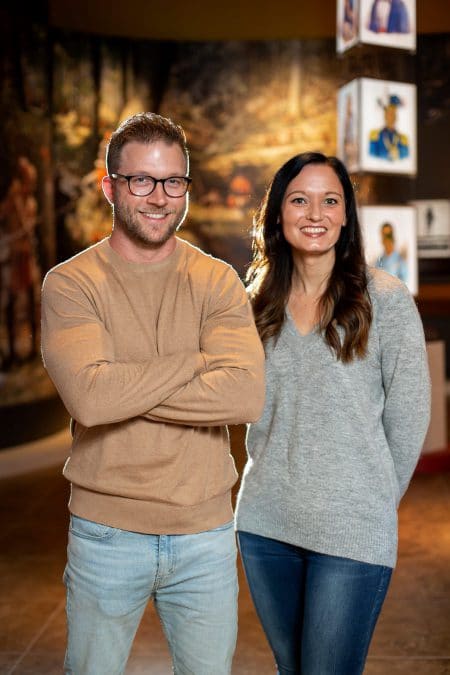“Remember the Raisin” became a rallying cry for the United States at the Battle of Frenchtown, also referred to as the Battle of River Raisin, in January of 1813. However, history often glosses over Native American influence in the War of 1812 surrounding Frenchtown near present-day Monroe, Michigan.
Knowing this, leaders at the River Raisin National Battlefield Park reached out to Citizen Potawatomi Nation Cultural Heritage Center staff when they began planning a documentary about the battle. CHC Director Dr. Kelli Mosteller and Curator Blake Norton began collaborating with National Park Service employees, NPS board members, tribes and others on creating a narrative for the video set for release within the next two years.

“They wanted the film to appeal to various audiences by telling the story in a correct way. That’s why we wanted to sign onto it,” Norton said.
Before becoming an official NPS park in 2009, the National Register of Historic Places recognized portions of the original Frenchtown battlefield as a historic landmark. Today, the River Raisin National Battlefield Park remains NPS’ only commemoration of the War of 1812.
“The film intends to provide a holistic look at the battle and correct misconceptions surrounding it that are very similar to the Battle of Fort Dearborn — this can only be done by understanding the perspectives of the tribes involved,” Norton said.
Battles of Frenchtown
As the end of 1812 approached, the English, Potawatomi and other Native allies began employing their final push in the war. Although the British and Native allies lost the initial Battle of Frenchtown on Jan. 18, 1813, they reconvened and launched a surprise attack on the American soldiers.
“With the recapture of Frenchtown in the Second Battle of the River Raisin, many Americans were taken prisoner and marched north to be ransomed. Those with wounds too severe were left at Frenchtown and killed by Native forces,” Norton said.
The Native alliance moved into Frenchtown and captured the settlement on Jan. 22, 1813, despite the fact the parties agreed to surrender terms. Because of this, many still refer to this conflict as a massacre.
Norton and Dr. Mosteller see the project as an opportunity to educate those making the film about the Potawatomi involvement in the battle as well discuss how word choice can influence messaging.
“It’s just like if you look at the Battle of Fort Dearborn, why is it referred to as a massacre when the Indians win and the white are killed, but it’s a battle when the white folks win and the Indians are killed? It may just be a difference in terminology, but it shapes the way an event is remembered by the public,” Dr. Mosteller said.
Teamwork
“It’s like being able to step back in time and work with allied tribes as one unit — one force to achieve a common goal,” Norton said of the documentary project.
The CHC staff often receives calls about various projects including books, short stories, movies and more, but these requests are not always genuine. However, from the beginning, CHC staff knew that the approach from the NPS varied from prior experiences.
“They wanted our perspective on this period and Potawatomi involvement in the battle,” Norton said. “And of course, we did have to correct a few things. As always, many of our Potawatomi warriors were overshadowed, which provided a great opportunity to introduce Main Poc and the role he played. They were aware of him; they just weren’t objectively capturing who he truly was and his impact during this period.”
Potawatomi Chief Main Poc served as an integral leader during the War of 1812. Although he did not completely agree with Tecumseh and his brother, The Prophet’s, platform, Main Poc encouraged the two Shawnee leaders to move from the Ohio area to his village in Indiana and established Prophetstown.
This project also gave a platform to explain and educate others on the differences between lived events, history and remembrances.
“History is shaping how you’re going to tell the story, where a remembrance is choosing to look at something that happened in the past and couch it in your interpretation that fits your agenda,” Dr. Mosteller said.
Battlefield sites and commemorative statues fall under a remembrance, Dr. Mosteller added, which makes the CHC’s involvement with the documentary’s development even more impactful — it offers an opportunity for the public to learn more than just one side of the story.
“They want their project to have legitimacy, and I think a lot of other organizations could take a note from them,” Dr. Mosteller said.
CHC staff had input on small and large aspects, including voice actors, narrative, imagery and more.
“Talk about inclusive; this was a very democratic process, and they were really good about it,” Dr. Mosteller said. “It wasn’t like if we didn’t reply about one aspect they didn’t include us in the next decision. They kept coming back and kept bringing us back into the fold and were really transparent about the process.”
For those who do not live near Tribal headquarters, visiting sites, like the River Raisin National Battlefield Park in Michigan, can help connect them to CPN’s history.
“To be able to look across the landscape and imagine it — having that resource there and available to them can drive it home in a way we may not have the opportunity down here because of removal,” she said.
Dr. Mosteller and Norton expect the documentary’s release within the next two years.
“It’s almost complete, but the editing process is going to be pretty extensive,” Dr. Mosteller said. “They want us to be included in post-production as well.”
Overall, CHC staff are excited and humbled by their experience working on the documentary.
“The project goes hand in hand with our mission at the CHC, which is to correctly and appropriately educate people on who the Citizen Potawatomi are as Bodéwadmi – as Nishnabe people,” Norton said.
For more information on the River Raisin Battlefield Park, visit nps.gov/rira.
